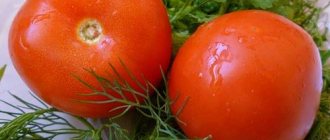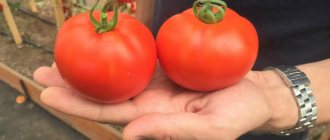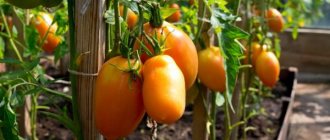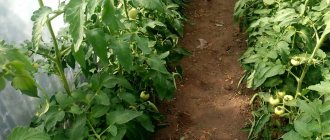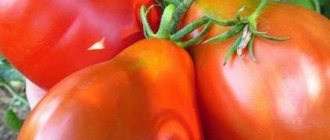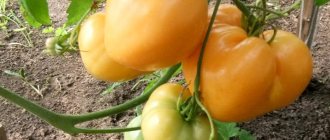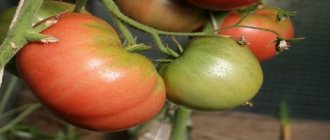Characteristics and description of the tomato variety Chanterelle
The Chanterelle tomato, bred, is an early-ripening, tall variety. Its main advantage is frost resistance and unpretentiousness: it grows well both indoors and outdoors. In northern latitudes, it is advisable to use agrofibre or film, which will protect the seedlings in the early stages of development. In the future, they can be abandoned.
The height of this determinate plant is about 110 cm, its stems are of medium thickness, the leaves are bright green, elongated in shape and small in size. The racemes are simple, the first inflorescences appear after the appearance of the 6th leaf, and subsequent ones - every 1 - 2 leaves. Ovaries of racemes - from 4 - 6 tomatoes, with a short, articulated stalk. The fruits have an oval, elongated shape with a sharp “fox” nose.
Ripe fruits are distinguished by their bright orange color, juiciness, and pronounced tomato taste and aroma. The surface of Chanterelle tomatoes is smooth, their skin is thin and soft. Not fully ripe, milky ripe fruits have a light yellow color, which changes to bright orange as they ripen. The size of one tomato does not exceed 150 g, has an elongated shape and three chambers containing small seeds.
Provided proper watering and feeding, the tomato will actively bear fruit: the expected crop yield is from 8.5 kg of tomatoes per 1 sq. m. The first tomatoes appear on the 110th day from the moment of germination.
Hybrid characteristics
An early-ripening, semi-determinate f1 tomato is intended for growing mainly in film and polycarbonate greenhouses, and in open beds. Seeds of Dutch selection. It takes 50–60 days from planting seedlings in the ground to harvesting. The bush requires gartering and shaping.
The height of the plant at maturity reaches a height of 1.7 meters. The root system is highly developed, the branches are powerful. One plant produces 8–9 clusters of fruits.
When ripe, tomatoes weigh 170–250 grams, so branches with fruits need to be tied up. One bunch will bear from 3 to 7 fruits at the same time. The fruits are smooth, slightly flattened, shiny. Mature ones have a bright red color; there is no green spot on the stalk. The taste is sweet, with sourness. The pulp is dense and juicy with a small number of small seeds.
Fruits of universal use. Reviews say that they are used to make juices, sauces and pastes. Marinated, salted and dried for seasoning. And excellent transportable qualities help tomatoes to be successfully sold in markets and stores. As you can see, this hybrid has solid positive qualities.
Pros and cons of the Chanterelle tomato variety
Judging by the characteristics and description of the Chanterelle tomato variety, as well as reviews from experienced gardeners, these tomatoes have a number of advantages. These include:
- Easy to care for. Chanterelle tomatoes grow well in closed and open ground and do not require constant feeding or frequent watering;
- Frost resistance. This is one of the few varieties that can tolerate frost. In addition, temperature fluctuations do not cause the ovaries to fall off;
- High yield;
- Resistance to verticillium and fusarium lesions;
- Early ripening, fruiting from July to the end of August and the ability to extend fruiting until frost;
- Decorative appearance of tomatoes resembling fox faces.
However, along with the advantages, Chanterelle has some disadvantages, which include:
- Relatively thin stems that need staking. If not properly cared for, the weight of a heavy fruit will cause the plant to bend to the ground and the tomatoes to rot;
- Susceptibility to late blight.
Reviews
Feedback from people is the best characteristic possible.
Among the comments on various resources, the following reviews can be highlighted:
- One woman planted these tomatoes and was extremely surprised that they were able to survive in open ground conditions. She grew them, but did not hope for a harvest from her planting, but despite everything, the bushes produced a fairly large number of fruits;
A farmer who was experiencing not the most successful of all his seasons said that he planted “Chanterelle” tomatoes out of despair, hoping for the veracity of reviews on the Internet. It completely met his expectations. Thanks to the presence of greenhouses, tomatoes could grow in comfortable conditions, which resulted in a very rich harvest. For him, this was the salvation of his business, and he highly recommended this variety to everyone else.
Optimal growing conditions
The unpretentiousness of the variety allows you to grow Chanterelle tomatoes in almost any climatic zone. The culture grows well not only in the southern and central parts of Russia, but also in northern latitudes. The only thing that an amateur gardener should remember is the use of film or agrofibre when covering the plant for the winter.
The Chanterelle tomato develops well in the greenhouse. Here you can achieve the maximum level of productivity. Since the Chanterelle tomato variety is susceptible to late blight, high humidity should be avoided during cultivation in a greenhouse.
Resistance to diseases and climatic conditions
Gardeners call the main difference between Chanterelle and other varieties its amazing resistance to unfavorable climatic conditions. Neither temperature changes, nor heat and drought or cold snaps will have a detrimental effect even on young seedlings. It should also be noted that there is high immunity to various diseases to which nightshade crops are usually exposed.
- When planting, it is necessary to leave at least 30 centimeters between the bushes;
- promptly remove lower and yellowed leaves;
- the pinching procedure will have a positive effect on the growth and resistance of the disease plant;
- Plants can only be watered at the roots; water should not get on the leaves and ovaries;
- the soil in the greenhouse should not be too wet, like the air;
- plants affected by late blight must be destroyed immediately - experienced gardeners recommend burning the bushes
Growing
It is worth starting to grow Chanterelle tomato seedlings no later than 60 - 65 days before planting in open ground. The ideal time is the end of March - beginning of April. Before planting, the seeds are carefully checked for empty or contaminated ones. After culling, future plants are disinfected in a weak solution of potassium permanganate, and then soaked in settled water for 3 to 4 days until the first shoots appear.
Peat pots are filled with ready-made soil or substrate. To do this, make depressions of about 1 cm. Fertilizer and 2 - 3 seeds are placed in each hole. Then cover with soil and water moderately. To improve germination, the pots can be covered with cling film for several days.
Growing seedlings
Proper cultivation of seedlings is the key to avoiding problems with the future plant.
Crops for Chanterelle tomato seedlings are carried out from the second half of March. Light nutritious soil mixtures are suitable for seeds: you can purchase a ready-made mixture. During the germination period, containers with seeds are covered with film, and the temperature should be within +23 - 24 °C. The germination period is about a week. The soil in the pots should not be allowed to dry out; to do this, the soil must be sprayed as it dries every 2 to 3 days.
From the moment the seedlings emerge, the container is moved to a lighted place, at a temperature of about +18 °C.
After the appearance of 1 - 2 true leaves, the young plants are picked and transplanted into separate containers.
After the first shoots appear, the film is removed, and future tomatoes are picked.
Landing rules
Seedlings can be transplanted into open ground in late May-early June, after the return frosts have subsided. Due to the characteristics of the variety, there is no need to wait for stable heat, which is important, first of all, for northern latitudes.
You should first place mineral fertilizers in the holes and only then transfer the seedlings there. If peat pots were used for forcing, then future tomatoes can be planted directly in them. The optimal scheme would be to plant 4 bushes per 1 square meter.
Further cultivation will require:
- garters of seedlings and partial pinching;
- infrequent watering: on average, once every 5 days;
- weeding and loosening after watering;
- complex fertilizers and foliar fertilizing.
Watering and fertilizing
The main rule of caring for any plant is proper watering. When growing Chanterelle tomatoes, you should not allow the water to stagnate or the soil to dry out. The recommended watering is at least 3 times a week; in particularly hot climates it can be increased to 5 or even 7 times. We must not forget about fertilizing, mulching and pinching.
Tomatoes can be fed with mineral and organic fertilizers with a frequency of 2 - 3 times during the season and, in addition, Chanterelle tomatoes need to be sprayed with foliar compounds once or twice.
Pinching and tying
Beginners in gardening have the idea that removing competing shoots is unnecessary, because more stems can produce more fruit. However, the stepsons absorb some of the nutrients and slow down the growth of the plant, the tomatoes become smaller, and the bush itself turns out lower and weaker than it could be with proper care. Non-standard Chanterelle tomato bushes produce shoots: they must be removed regularly, however, without overusing pinching.
Below the first flower cluster, the very first and strongest stepson usually develops: it can be left. Other competitors should be removed in a timely manner. At the same time, you need to pinch off the shoots early in the morning on a sunny day and no more than two stepsons at a time.
Tomatoes of the Chanterelle variety should be tied to pegs immediately after planting in open ground or in a greenhouse.
Formation
Proper plant formation is the key to high productivity. With chanterelle tomatoes, you need to stick to the golden mean: without getting carried away with pinching, you shouldn’t create a jungle on your plot. Bushes need not only timely removal of stepsons, but also lower leaves. Upon reaching the maximum height, the distance from the ground to the foliage should be at least 30 cm. The Chanterelle tomato bush is formed into 2 - 3 stems.
Protection from diseases and pests
Chanterelle tomatoes are unpretentious varieties that are less susceptible to pests and diseases, but errors in care can have fatal consequences. Most problems can be avoided by resorting to timely mulching.
The method consists of covering the soil under the plant with mulch - sawdust, shavings, pine needles, hay or nut shells. This protects the plant from rotting, prevents soil erosion, and protects the bush from splashes from the ground hitting the bush and infecting it with diseases.
In excessively damp and cool greenhouses, tomatoes can be affected by gray rot: it quickly spreads along the stem and leaves of the bush, which can lead to the death of the entire plant. To prevent the development of the disease in Chanterelle tomatoes, it is necessary to provide a residual amount of lighting and heat.
Fungal diseases are treated well with drugs such as Trichodermin and Previkur.
Tomato care
Almost all varieties of tomatoes need a lot of moisture. That is why the soil in the greenhouse or garden bed should not be allowed to dry out. Watering should be done regularly, using only warm water. Try to ensure that moisture does not get on the leaves and that the soil in the greenhouse does not become waterlogged. From time to time, bushes need to be treated with antifungal drugs. Loosening, weeding and mulching will be needed as necessary. For the latter, leaves, sawdust and mowed grass are suitable. A month after you plant the Chanterelle in a permanent place, the lower leaves need to be removed. To keep the fruits large and juicy, 7 clusters should be left on the stems. It is recommended to feed the plants three to four times: mineral complexes or organic fertilizers are suitable. It is extremely important to apply them during the period of flowering and fruit formation.
Productivity
During the season, each Chanterelle tomato bush forms from 7 to 10 clusters with small, about 100 g, calibrated tomatoes. On average, the yield per bush is 2.8 - 3 kg and 8.5 to 9.5 kg per square meter. m.
This means that cultivating Chanterelle tomatoes is an economically profitable business. And resistance to low temperatures allows you to prolong fruiting until the first frost.
Important! Chanterelle tomatoes can be stored with preservation of quality for up to 3 weeks, in a dark, cool (+5 - 12 ° C) room with relative air humidity (about 80%).
Reviews from gardeners
Polina Medvedeva, Volgograd
My Chanterelle tomatoes are one of those “must be planted” tomatoes. I’ll explain why: in rainy, cold summers they simply save me, and in general, in any weather they can withstand both heat and cold dampness. The harvest is always plentiful and the taste is excellent. You just need to wait until they are fully ripe for the tomatoes to be tasty and sweet - they should have a deep orange color. Well, you can put slightly unripe ones in a jar. They are some of the most beloved ones when preserved: they have an unusual color and shape, they are tasty, they are always intact, and the skin does not crack. I rarely use it for juice (only to collect seeds), more often with other varieties so that the color is beautiful.
Natalia Korovaeva, Kamensk-Shakhtinsky
A friend gave Chanterelle tomatoes as seedlings and highly praised them. Indeed, I was also satisfied. I didn’t notice any difficulties in caring for it; I had to tie it up. But I’m so used to it, I tie up all the tomatoes so that they don’t get dirty. They watered when there was time, often even only on weekends, but the harvest was pleasing, so they closed it and ate it. Tomatoes are dense, good to take with you on the road. We will plant more.
Evgenia Prikhodko, Old Poltavka
My bushes are not tall, maybe because I don’t pamper them, only half a meter. And I’m not tying it up. I water it a couple of times a week, I don’t feed it. Chanterelle has been producing good harvests for several years now. And I really like the tomatoes themselves because of their fleshy flesh, just oily, and delicate sweetish taste. Oh, how good they are when preserved! The tomatoes are very early, the first to hit the table. The color is also amazing!
How to grow tomatoes
After 2 months at home, the seedlings are ready to be planted in the ground. At the time of transplantation, the bushes have at least 6-7 true leaves, a strong stem and a developed root system.
Landing
The soil is prepared 10 days before transplantation. They dig it up, loosen it and add a bucket of compost and 1 cup of wood ash per 1 square meter. m.
Seedlings are planted in shallow holes in the morning or evening. Planting pattern: 40 cm – distance between seedlings, 60 cm – between rows. For 1 sq. m place 5 – 6 plants. If the bed is in a very sunny place, the seedlings will be shaded for the first few days. This way they will grow faster and will not get burned.
Further care for the Marusya tomato
Regular watering is established as the seedlings adapt to new conditions. Water once a week under the root with warm, settled water. Since the crop is susceptible to late blight, the fungicide “Fitosporin” is added to the irrigation (1 tablespoon per 10 liters of water). The drug additionally protects young plants from fungal spores.
After watering, the soil is loosened, removing weeds with roots. To retain moisture in the beds, they are mulched with peat or straw.
Until the plants have become stronger, it is important not to flood the soil, as waterlogging will negatively affect the root system and there is a risk of developing diseases. Do not forget that tomatoes tolerate drought very well, much better than high humidity.
2 weeks after transplantation, the seedlings are fed with fertilizer containing mainly potassium and phosphorus. This feeding is carried out once every 2 weeks. 2 weeks before the start of fruiting, the plants are fed with organic matter, for example, bird droppings in a ratio of 1:15.
Features of care and possible difficulties
Stepchildren of the crop are mandatory: the development of unnecessary shoots threatens to reduce the yield. All stepsons are removed under the first flower brush. If the tomato crown is thick and lush, thin it out. The pinching procedure is carried out in the morning, treating the cut sites with a weak solution of potassium permanganate to prevent infection.
Despite their small growth, the bushes need timely garter. The fruits ripen in whole clusters, like bunches of grapes, and the bushes cannot support the weight of the ripe fruits.
A wooden or metal support is installed next to each plant, to which the stem and fruit-bearing branches are fixed. Another fixation option is a garter on a trellis. Supports are installed on different sides of the beds and wire is pulled between them. Tomato branches are tied to a horizontally stretched wire with soft fabric ribbons.
Diseases and pests
The crop is characterized by increased resistance to Verticillium and Fusarium leaf wilt, but it cannot independently resist late blight. Therefore, it is initially necessary to carry out preventive measures to prevent the development of fungal infection.
Prevention includes:
- monitoring the soil moisture level: do not forget that tomatoes do not tolerate waterlogging;
- regular loosening;
- systematic ventilation of closed structures;
- removing the lower leaves;
- spraying with “Fitosporin” once every 2 weeks;
- treating the land with copper sulfate.
When affected by fungus, plants are treated with the preparation “Hom” containing copper oxychloride. The solution is prepared by dissolving 40 g of the drug in 10 liters of water.
To combat the Colorado potato beetle, the “Prestige” product is used. After treatment with an insecticide, the plants must be carefully inspected for any remaining pests. The beetle and its larvae are collected by hand.
To prevent slugs, the stems of the bushes are treated with a soap solution. The solution is prepared from 1 piece of laundry soap dissolved in 1 bucket of water.
Tomatoes are saved from flying insect pests by strong-smelling plants planted nearby.
Features of planting and growing in open ground
Growing in open ground involves obtaining seedlings in a greenhouse or greenhouse. Despite all its unpretentiousness and frost resistance, it is still a tomato, so it has its own requirements for growth conditions.
Important! Seeds are planted 55–60 days before transplanting young bushes into open ground.
Like any other tomato, Chanterelle prefers to grow in moderate humidity and maximum warmth. If such conditions cannot be achieved, you need to reduce watering to a minimum and help the plants get maximum heat and light.
Before planting, the seeds must be treated, preparing them for the difficult conditions of germination and further growth:
- visual inspection of seed material and rejection of empty grains;
- disinfection in a solution of potassium permanganate - 15–20 minutes;
- soaking in filtered neutral water for 2–3 days until the sprouts hatch.
After this, the seeds are planted in plastic or peat cups with soil for vegetables, 2-3 pieces each. If the soil is not purchased and has not been prepared in advance, it should be spilled with a light solution of potassium permanganate.
